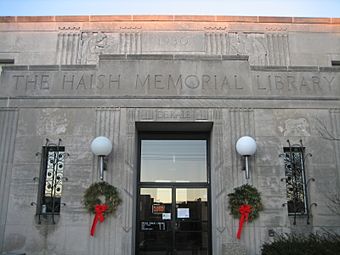Haish Memorial Library facts for kids
Quick facts for kids |
|
|
Haish Memorial Library
|
|
 |
|
| Location | 309 Oak St., De Kalb, Illinois |
|---|---|
| Area | less than one acre |
| Built | 1930 |
| Architect | White & Weber |
| Architectural style | Art deco, Art Moderne |
| NRHP reference No. | 80004319 |
| Added to NRHP | October 9, 1980 |
The Haish Memorial Library, also known as the DeKalb Public Library, is a special building in DeKalb, Illinois. It was designed by architects White and Weber from Chicago. The library was built in the Art Deco style, which was popular in the 1930s. Funds for the building came from Jacob Haish, who left money for the library in his will in 1928. This historic building was added to the National Register of Historic Places in 1980.
A Gift from Jacob Haish
The Haish Memorial Library officially opened in 1931, after being built in 1930. It was made possible by a generous gift of $150,000 from Jacob Haish. This was a very important moment for the DeKalb Library. Before this, the library didn't have its own building.
The library used to be in different places. First, it was on the second floor of the city hall. Later, it moved to 125 S. 2nd Street in DeKalb. From 1923 until the Haish Library was finished, it was located on the second floor of the Daily Chronicle building on Lincoln Highway.
Design and Features
The outside of the library is made from a beautiful stone called Indiana Bedford limestone. This stone shows off the Art Deco style, which was very popular in the 1920s and 1930s. The architects, White & Weber from Chicago, designed the building to hold a huge number of books – about 80,000!
The library also had a special exhibition hall. This hall had its own entrance, so people could visit it separately. The main entrance to the library features a lovely formal garden. In 1979, a big new part was added to the library, called the West Wing. This addition helped the library serve even more people.
A Historic Landmark
In 1980, the Haish Memorial Library was added to the National Register of Historic Places. This means it's recognized as an important historic site. It joined other famous landmarks in DeKalb with this special honor. Some of these include the Egyptian Theatre, the Gurler House, the Ellwood House, and the Glidden House. These places help tell the story of DeKalb's past.



